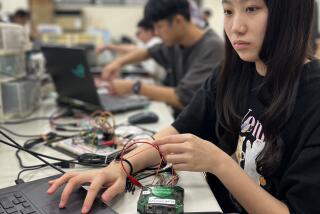At expo for engineers, future of solder reigns
Enough with the dillydallying. It’s time to get the lead out.
That seemed to be the rallying cry Wednesday when nearly 10,000 space-age engineers gathered in Los Angeles to talk motherboards, modules and meltdowns as the computer circuit world faces its biggest challenge in its 70-year existence.
The experts are attending the Printed Circuits Expo at the Los Angeles Convention Center. The six-day conference, sponsored by the trade group IPC, ends today with seminars on integrated circuits and manufacturers’ demonstrations of a new breed of environmentally friendly computer innards.
At issue is the use of solder in the production of circuit boards.
The silvery, easily melted tin-lead alloy has been used to securely connect wires since the first radio went on the market in the 1920s. Since the 1950s, solder also has routinely been used to cover circuit boards’ minute strands of copper.
But new European manufacturing standards ban the use of solder with lead in it. Three U.S. states, including California, are considering doing the same. And experts were predicting Wednesday that the United States might not be far behind.
So new circuit-board plating methods -- perhaps using gold, silver or a type of nickel -- are being considered as replacements for solder plating. But besides being expensive, they could come with another cost: heat.
“When they take lead out of solder, the metals have to be melted at higher temperatures and it increases the risk of product failure,” said Bill Birch, president of a Canadian firm, PWB Interconnect Solutions Inc.
His company does high-tech testing that can replicate 25 years of wear and tear on a circuit board in only one day.
Richard Barnett, a Houston procurement manager for Hewlett-Packard, quizzed Birch as to whether his equipment could gauge a component’s quality “through the thermal cycling” likely to take place with higher manufacturing temperatures.
“You want your cellphone to work every time you pick it up,” Barnett said.
Across the sprawling convention center hall, engineers were thinking the same thing.
“The issue everybody is addressing, really, is ‘lead-free,’ ” said Beatriz Bennett, a quality-control engineer for Lockheed Martin of Dallas. “It’s a challenge. But the environment will be the winner in the long run.”
Rene Valentin, a Hewlett-Packard engineer from Puerto Rico, said he was disappointed by some of the convention’s professional seminars. He is still looking for a solder solution.
“Maybe people aren’t sharing all they know about the lead-free area. Or maybe it’s just that people don’t know that much about it yet,” he said with a shrug.
Still, the mood was upbeat, although this is no consumer electronics show, where Nintendo Wii video game displays and the latest in home television theaters line every aisle.
Near the back of the hall, printed circuit pioneer Dieter Bergman of Deerfield, Ill., was showing off circuit boards from the early 1950s and telling younger engineers of the time in 1959 when he designed them for the Philco Co., which made consumer radios and TVs -- and components for Navy Sidewinder missiles.
“The move from vacuum-tube technology to circuit boards lined with transistors, capacitors and diodes improved reliability and functionality,” said Bergman, 76. Consumer products eventually benefited, although “the original patents were all for military applications.”
A hundred yards away, Steven Howland held up a tiny printed circuit the same size as the one Bergman had shown off. It fits on a new super computer -- the kind commissioned by the government today.
“This is 10 million times more powerful” than Bergman’s, said Howland, product manager for Endicott Interconnect Technologies Inc., an IBM spinoff based in Endicott, N.Y.
What hasn’t changed is the shift to small and smaller. “Weight is more valuable than gold. Everything is about miniaturization,” he said.
Which means that even without their solder, the engineers will soldier on.







